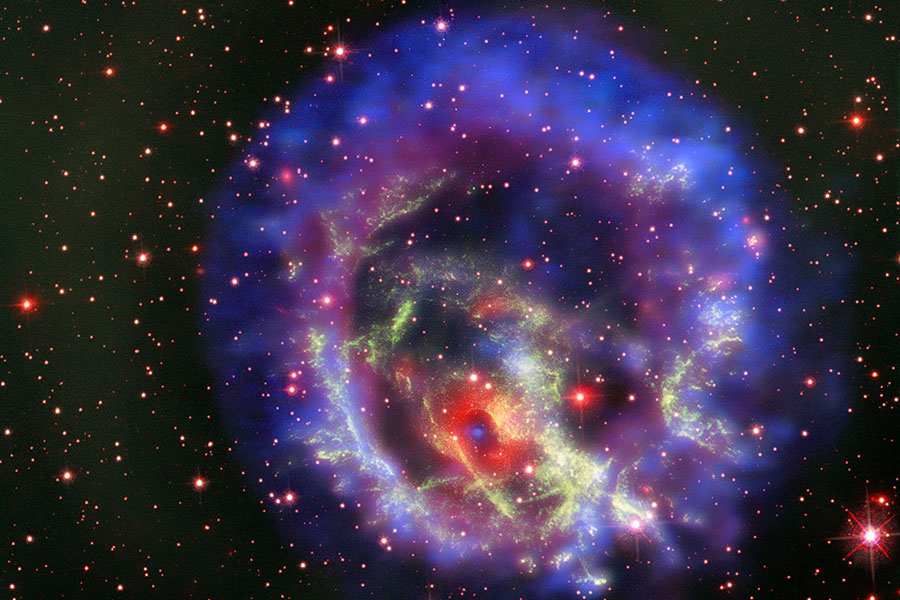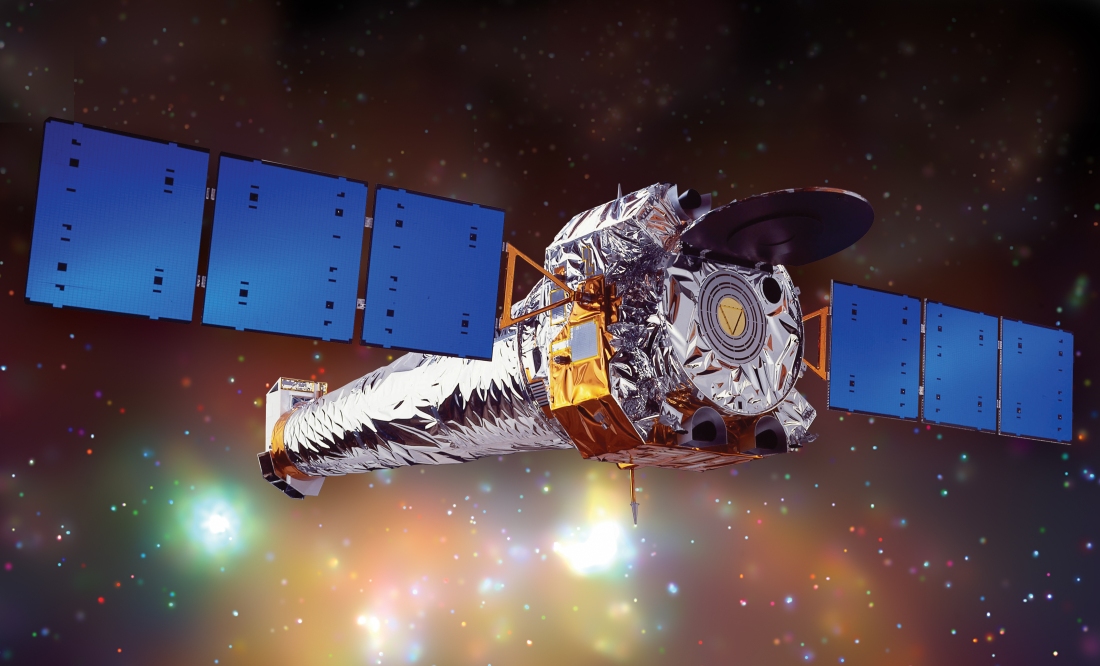From Florida State University (US)
May 13, 2021
Kathleen Haughney
khaughney@fsu.edu

A composite image of the supernova 1E0102.2-7219 contains X-rays from Chandra (blue and purple), visible light data from VLT’s MUSE instrument (bright red), and additional data from Hubble (dark red and green). A neutron star, the ultra dense core of a massive star that collapses and undergoes a supernova explosion, is found at its center. Photo courtesy of National Aeronautics Space Agency (US).




When a massive star dies first there is a supernova explosion. Then what’s left over becomes either a black hole or a neutron star.


That neutron star is the densest celestial body that astronomers can observe, with a mass about 1.4 times the size of the sun. However, there is still little known about these impressive objects. Now, a Florida State University researcher has published a piece in Physical Review Letters arguing that new measurements related to the neutron skin of a lead nucleus may require scientists to rethink theories regarding the overall size of neutron stars.
In short, neutron stars may be larger than scientists previously predicted.
“The dimension of that skin, how it extends further, is something that correlates with the size of the neutron star,” said Jorge Piekarewicz, a Robert O. Lawton Professor of Physics.
Piekarewicz and his colleagues have calculated that a new measurement of the thickness of the neutron skin of lead implies a radius between 13.25 and 14.25 kilometers for an average neutron star. Based on earlier experiments on the neutron skin, other theories put the average size of neutron stars at about 10 to 12 kilometers.
Piekarewicz’s work complements a study, also published in Physical Review Letters, by physicists with the Lead Radius Experiment (PREX) at the DOE’s Thomas Jefferson National Accelerator Facility (US). The PREX team conducted experiments that allowed them to measure the thickness of the neutron skin of a lead nucleus at 0.28 femtometers — or 0.28 trillionths of a millimeter.
An atomic nucleus consists of neutrons and protons. If neutrons outnumber the protons in the nucleus, the extra neutrons form a layer around the center of the nucleus. That layer of pure neutrons is called the skin.
It’s the thickness of that skin that has captivated both experimental and theoretical physicists because it may shed light on the overall size and structure of a neutron star. And though the experiment was done on lead, the physics is applicable to neutron stars — objects that are a quintillion (or trillion-million) times larger than the atomic nucleus.
Piekarewicz used the results reported by the PREX team to calculate the new overall measurements of neutron stars.
“There is no experiment that we can carry out in the laboratory that can probe the structure of the neutron star,” Piekarewicz said. “A neutron star is such an exotic object that we have not been able to recreate it in the lab. So, anything that can be done in the lab to constrain or inform us about the properties of a neutron star is very helpful.”
The new results from the PREX team were larger than previous experiments, which of course affects the overall theory and calculations related to neutron stars. Piekarewicz said there is still more work to be done on the subject and new advances in technology are constantly adding to scientists’ understanding of space.
“It’s pushing the frontiers of knowledge,” he said. “We all want to know where we’ve come from, what the universe is made of and what’s the ultimate fate of the universe.”
Piekarewicz’s co-authors are Brendan Reed and Charles Horowitz from Indiana University (US) and Farrukh Fattoyev from Manhattan College-CUNY (US).
This work is funded by the Department of Energy (US).
See the full article here .
five-ways-keep-your-child-safe-school-shootings
Please help promote STEM in your local schools.
One of the nation’s elite research universities, Florida State University (US) preserves, expands, and disseminates knowledge in the sciences, technology, arts, humanities, and professions, while embracing a philosophy of learning strongly rooted in the traditions of the liberal arts.
FSU’s welcoming campus is located on the oldest continuous site of higher education in Florida, in a community that fosters free inquiry and embraces diversity, along with championship athletics, and a prime location in the heart of the state capital.
Florida State University is a public research university in Tallahassee, Florida. It is a senior member of the State University System of Florida. Founded in 1851, it is located on the oldest continuous site of higher education in the state of Florida.
The university is classified among “R1: Doctoral Universities – Very high research activity”. The university comprises 16 separate colleges and more than 110 centers, facilities, labs and institutes that offer more than 360 programs of study, including professional school programs. The university has an annual budget of over $1.7 billion and an annual economic impact of over $10 billion. Florida State is home to Florida’s only national laboratory, the National High Magnetic Field Laboratory, and is the birthplace of the commercially viable anti-cancer drug Taxol. Florida State University also operates the John & Mable Ringling Museum of Art, the State Art Museum of Florida and one of the largest museum/university complexes in the nation. The university is accredited by the Southern Association of Colleges and Schools (SACS).
For 2021, U.S. News & World Report ranked Florida State tied for the 19th best public university in the United States in the national university category.
FSU’s intercollegiate sports teams, commonly known by their “Florida State Seminoles” nickname, compete in National Collegiate Athletic Association (NCAA) Division I and the Atlantic Coast Conference (ACC). In their 113-year history, Florida State’s varsity sports teams have won 20 national athletic championships and Seminole athletes have won 78 individual NCAA national championships.
Research
As one of the two primary research universities in Florida, Florida State University has long been associated with basic and advanced scientific research. Today the university engages in many areas of academic inquiry at the undergraduate, graduate and postdoctoral levels.
Florida State University was awarded $268.5 million in annual research expenditures, in sponsored research in fiscal year 2016. FSU is one of the top 15 universities nationally receiving physical sciences funding from the National Science Foundation (US).
Florida State currently has 19 graduate degree programs in interdisciplinary research fields. Interdisciplinary programs merge disciplines into common areas where discoveries may be exploited by more than one method. Interdisciplinary research at FSU covers traditional subjects like chemistry, physics and engineering to social sciences.



